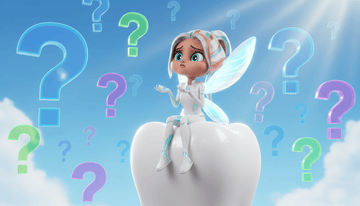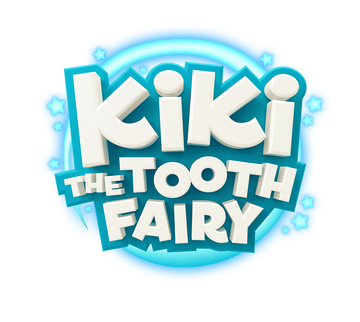Every parent faces it sooner or later. Your child looks up at you with a wiggly tooth and asks, “Is the Tooth Fairy real?”
It can feel tricky. Do you protect the magic? Do you tell the truth? Or something in between? This guide explains why kids ask, how to answer at every age, and simple ways to keep the magic alive.
Why Kids Ask in the First Place
Most kids start asking questions about the Tooth Fairy between 6 and 9 years old. The reasons usually fall into a few common themes:
- Developmental stage: Around age six, children enter what psychologists call the “concrete operational stage.” They start applying logic, comparing what they see with what they are told. If they see no wings or glitter dust, they begin to wonder.
- Comparison with other myths: Kids often group the Tooth Fairy with Santa Claus and the Easter Bunny. Once one story starts to crumble, they question the others.
- Influence from peers and siblings: An older sibling or a confident classmate who proudly announces “the Tooth Fairy isn’t real” can spark doubts immediately.
- Testing trust: Children sometimes ask not because they doubt, but because they want to see how you respond. They are gauging your honesty as much as the Fairy’s existence.
For more on the cultural side of the tradition, see Tooth Fairy on Wikipedia. Traditions around lost teeth exist across the world, and your child may hear different versions that make them curious.
How to Answer by Age
The right answer depends on your child’s age and personality. A five-year-old needs reassurance and imagination. An eight-year-old may want a blend of magic and logic. A ten-year-old may be ready to join the tradition as a helper.
For Younger Kids (4–6)
At this age, children crave wonder. The more magical the better.
“Yes, the Tooth Fairy is real. She flies through the night, collects teeth, and leaves treasures only she can carry.”
Other answers you can use:
- “The Tooth Fairy knows every child who loses a tooth. She will never miss you.”
- “Her wings glow in the dark, and she sprinkles fairy dust wherever she goes.”
- “She is friends with other magical helpers like Santa’s elves.”
What not to say: avoid sarcasm or jokes at this age. Children take things literally and may feel hurt if you laugh at their belief.
For Growing Kids (7–9)
Children this age are logical but still hopeful. They want you to keep the magic alive, even if they suspect the truth.
“The Tooth Fairy is part of a special tradition. Parents help her magic reach every child, so the story keeps going.”
Other answers you can use:
- “The magic is real because families make it real.”
- “Even if she needs help, the story is alive every time a child finds a surprise.”
- “The Tooth Fairy may be invisible, but she is real whenever kids wake up with joy.”
What not to say: don’t dismiss their question outright with “you’re too old to believe.” That risks breaking trust and closing the door to conversation.
For Tweens (9+)
By this age, most kids already know the truth or have strong suspicions. Instead of denying, invite them into the tradition.
“The Tooth Fairy may not be a tiny person with wings, but the tradition is real. Now you get to help carry it on for younger kids.”
Other answers you can use:
- “She is real in the way holidays are real. People keep the story alive.”
- “Now that you know the secret, you are part of the team that makes the magic happen.”
- “You can help me set up surprises for your younger siblings or cousins.”
What not to say: avoid blunt statements like “She isn’t real, I made it up.” That can feel like betrayal. Frame it as passing on a tradition instead.
What You Can Say Right Away
If your child’s question catches you off guard, here are quick answers you can lean on:
- “The Tooth Fairy is as real as the magic you feel when you check under your pillow.”
- “She is real because her story has been shared for generations.”
- “The magic doesn’t stop when you know the secret. That’s when you become part of it.”
Keeping the Tooth Fairy Magic Alive
Even if your child knows the truth, you can keep the tradition fun. In fact, many parents say the magic feels stronger when kids are old enough to help.
- Write an official Tooth Fairy letter. Make it tiny, add glitter, and sign it with a flourish. See these dentist-recommended examples for simple inspiration.
- Leave creative gifts instead of coins. Try glow-in-the-dark stars, stickers, or a keepsake box. For more inspiration, see our guide: 25 Tooth Fairy Ideas Kids Actually Love.
- Create a magical video moment. Personalized videos like Kiki the Tooth Fairy let kids see the Tooth Fairy speak to them by name. It turns a simple tradition into a lasting memory.
Why the Tooth Fairy Is Not the Same Everywhere
The Tooth Fairy feels universal today, but she has not always been the star. Different cultures created their own ways to celebrate a lost tooth:
- Mice and good luck: In France and Spain, a mouse replaces the tooth. Strong mouse teeth symbolized healthy growth. See The Little Mouse.
- Burial and protection: In parts of Asia and the Middle East, children bury or hide teeth to keep them safe from animals or spirits.
- Modern fairy magic: In the United States and the United Kingdom, a tiny winged fairy became popular in the early 1900s, thanks to children’s books and advertising.
Every culture has one thing in common: turning a small rite of passage into something magical.
FAQs About the Tooth Fairy
What age do kids stop believing in the Tooth Fairy?
Most children stop between 7 and 9, though some keep it alive longer if the tradition remains fun. Younger children often continue if older siblings play along.
How do I tell my child the Tooth Fairy is not literal?
Match your answer to their age. Younger children enjoy magic and may not be ready. Older kids appreciate honesty framed as an invitation to carry on the tradition. A gentle approach prevents disappointment and keeps trust intact.
Is it okay to keep the tradition after kids know the truth?
Yes. Many families continue with letters, notes, or small gifts. At that point, it becomes less about belief and more about family bonding. Some kids even enjoy helping parents prepare surprises for siblings.
How much money should the Tooth Fairy leave?
There is no rule. The current United States average is about $5 per tooth, according to the Delta Dental Original Tooth Fairy Poll. Some families give a coin, others a bill, and some use small toys instead. The best amount is one that feels special but sustainable for your family.
What if I forget to leave money under the pillow?
Do not panic. Many parents have slipped up. You can spin it into extra magic with a delay story (“her wings got tangled”), a bonus coin, or a morning delivery. For more ideas, see our upcoming guide: What to Do If You Forget Tooth Fairy Money.
Why do we even have a Tooth Fairy?
The Tooth Fairy tradition grew in the United States in the early 1900s. It was partly inspired by European customs of giving gifts or coins for teeth and became widespread thanks to children’s books and magazine features. By the mid-20th century, the Tooth Fairy was cemented as a cultural icon.
How do I keep older siblings from spoiling the secret?
Involve them. Tell them they are now “guardians of the magic” and give them small roles—like sprinkling glitter, writing notes, or placing gifts. This way, they feel empowered instead of eager to ruin the fun.
Final Thought
So, is the Tooth Fairy real? She is real in the same way childhood magic is real. As long as your child believes, the story lives on. Parents may carry the wings, but the wonder belongs to children.






